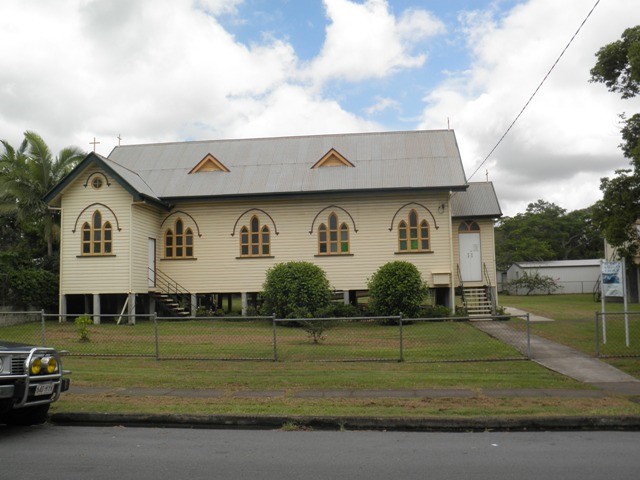Addresses
Type of place
Church
Period
Interwar 1919-1939
Style
Carpenter Gothic
Addresses
Type of place
Church
Period
Interwar 1919-1939
Style
Carpenter Gothic
The Church of St John the Divine at Oxley was built in 1928 by the Oxley Anglican community in response to the spiritual needs of the congregation. Prior to the construction of the church the Anglican community in Oxley had held their services in the non-denominational church on Oxley Road close to Ipswich Road. Built at a time of increased settlement in the Oxley area the Church of St. John the Divine was officially opened by Brisbane Anglican Archbishop Sharp on the 15 December 1928. As a centre for worship for the Oxley Anglican community since the interwar period the Church of St John the Divine has played an important role in the Oxley community.
Lot plan
L69_RP29498; L70_RP29498; L71_RP29498
Key dates
Local Heritage Place Since —
Date of Citation —
Construction
Roof: Corrugated iron;Walls: Timber
People/associations
Oxley Anglican community (Association)Criterion for listing
(A) Historical; (D) Representative; (G) SocialInteractive mapping
Lot plan
L69_RP29498; L70_RP29498; L71_RP29498
Key dates
Local Heritage Place Since —
Date of Citation —
Construction
Roof: Corrugated iron;Walls: Timber
People/associations
Oxley Anglican community (Association)Criterion for listing
(A) Historical; (D) Representative; (G) SocialInteractive mapping
History
By the late nineteenth century Oxley had two main areas of development. The first was along Ipswich Road where the hotel had been established. Businesses such as a store, a butcher and a blacksmith shop were established as the population slowly increased and the need for services arose. In 1864 a non-denominational church was built near the corner of Bannerman and Ipswich Roads and the first Oxley school was built in 1873 with 32 enrolments when opened. This area became known as Oxley Central. The second area of development in Oxley was beside the railway station. However, this was slower to develop commercially than the first. Further development occurred in Oxley in the interwar period with new businesses being established beside the railway station.
Prior to the construction of St. John the Divine Church in Oxley the Anglican community in the area had held their services in an older non-denominational church on Oxley Road, close to Ipswich Road. This church had originally been built in 1864 and by the interwar period the trustees of this church were predominantly Anglican. However, by 1922 the trustees of this church had passed away without appointing further trustees. The property, therefore, was vested to the Public Curator in this year. As a result the Anglican congregation at Oxley was to be without a place of worship as soon as the property had been sold on.
However, in 1920 the Reverend A. L. Brine from St. Matthew’s Church at Sherwood had donated portion of land to the Oxley Anglican congregation. The parcel of land was situated closer to the Railway Station and the main settlement in Oxley at this time than the older church. On Saturday 25 August 1928 the stump capping ceremony took place prior to the construction of the church. An article in The Brisbane Courier in August 1928 described the design of the church, “The building will be constructed of hardwood chamfer boards, and lined with celotex. The length will be 52ft. overall, the width 32ft. across the sanctuary, and 22ft. across the nave. It will contain two vestries also”. (The Brisbane Courier, Saturday 18 August 1928, p.7) It went on to state, “Beside the satisfaction of having a building entirely of their own, the new church will be more centrally situated, and the congregations should therefore be appreciably augmented each Sunday”.
The rector of the parish was, at this time, the Reverend W. E. C. Barrett, of Sherwood. On the 15 December 1928 Archbishop Sharp officially dedicated the completed church. By November 1930 Reverend A. E. Attkins became the Anglican minister at the Oxley parish.
Statement of significance
Relevant assessment criteria
This is a place of local heritage significance and meets one or more of the local heritage criteria under the Heritage planning scheme policy of the Brisbane City Plan 2014. It is significant because:
References
-
Judy Gale Rechner, Brisbane House Styles 1880 to 1940: a guide to the affordable house, Brisbane: Brisbane History Group Studies No. 2, 1998
-
Historic Titles, Department of Environment and Resource Management
-
Queensland Post Office Directories
-
Metropolitan Water and Sewerage Survey Maps
-
Brisbane City Council, Register of New Buildings
-
Jenkins, Lesley, A Celebration of Culture: A Social History of Darra, Living in Brisbane, 2003
-
Fones, Ralph, Oxley! A Mind of its Own, Oxley-Chelmer History Group, 2006
-
Grantham, Lona, Heritage Tour: An Historical Tour of Oxley, Oxley-Chelmer Historical Group, 2003
Citation prepared by — Brisbane City Council (page revised June 2022)

